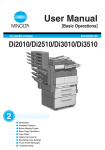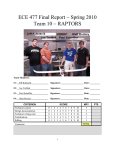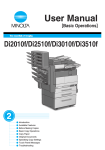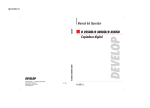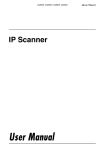Download User Manual hjGDH PageScope Light & Scanner Mode
Transcript
User Manual SU2/3 www.minoltaeurope.com The essentials of imaging PageScope Light & Scanner Mode Contents Contents 1 2 3 4 Before Making Connections and Specifying Settings 1.1 Welcome ........................................................................................1-1 1.2 Safety Precautions........................................................................1-2 General precautions ...................................................................1-2 Trademark Acknowledgements ..................................................1-3 1.3 User Instructions...........................................................................1-4 For the U.S.A. Users ..................................................................1-4 For Canada Users ......................................................................1-4 For European Users ...................................................................1-4 For Users of the Class B regulation’s countries .........................1-5 For Users except the Class B regulation’s countries..................1-5 1.4 Enclosed Accessories ..................................................................1-6 1.5 Preparing the LAN Cable and IP Address...................................1-6 1.6 Acceptance of the End User License Agreement ......................1-7 1.7 Compatible Operating Systems...................................................1-7 1.8 Operating Environment of Utilities..............................................1-7 1.9 Specifying the IP Address............................................................1-8 Making Connections 2.1 LAN Connection ............................................................................2-1 Connecting the LAN cable..........................................................2-1 LED indicators ............................................................................2-2 2.2 Environments for Transmitting Scan Data .................................2-3 Required environment ................................................................2-3 Network Settings 3.1 List of Network Settings ...............................................................3-1 3.2 Specifying Network Settings........................................................3-4 Displaying the Network Settings screen .....................................3-4 Printing the list of settings...........................................................3-6 Installing the Utilities 4.1 Utilities disk ...................................................................................4-1 4.2 Installing IP Scanner (Windows Me, 98/95, XP, Scanner Mode & Page Scope Light i Contents 2000 and NT4.0) ............................................................................ 4-1 4.3 5 Features of the Network Functions 5.1 6 7 ii Uninstalling IP Scanner ............................................................... 4-6 Uninstalling IP Scanner (Windows Me, 98/95 and NT4.0) ......... 4-6 Uninstalling (Windows XP and 2000)......................................... 4-7 Scan to E-mail ............................................................................... 5-2 5.2 Scan to Server (FTP) .................................................................... 5-3 5.3 Scan to PC (FTP) .......................................................................... 5-5 5.4 Scan to HDD .................................................................................. 5-5 5.5 Internet Faxing.............................................................................. 5-6 5.6 IP Address FAX (LAN-FAX) ......................................................... 5-7 5.7 Scan to PC (SMTP) ....................................................................... 5-8 5.8 IP Scanner ..................................................................................... 5-9 5.9 Document Forwording/Archive Distribution ............................ 5-10 5.10 Network Fax Transmission........................................................ 5-11 Using PageScope Light 6.1 System Requirements.................................................................. 6-1 Computer (Software).................................................................. 6-1 Network ...................................................................................... 6-1 Di3510/Di3010/Di2510/Di2010/Di3510f/Di3010f/ Di2510f/Di2010f ......................................................................... 6-1 Network Interface Card .............................................................. 6-1 Any of the following options must be installed. .......................... 6-1 6.2 Accessing PageScope Light ....................................................... 6-3 6.3 Using PageScope Light ............................................................... 6-4 6.4 Logging Into Administrator Mode ............................................... 6-4 6.5 Selecting the Display Language ................................................. 6-6 6.6 Structure of Pages........................................................................ 6-7 Performing a Scan to E-Mail Operation 7.1 Basic Transmission...................................................................... 7-1 If the transmission could not be completed................................ 7-3 7.2 Selecting a Recipient From the List on the One-Touch Screen........................................................................ 7-5 7.3 Selecting a Recipient by Searching for It by Name................... 7-6 Scanner Mode & Page Scope Light Contents 7.4 Typing In the Number of the One-Touch Key for the Recipient ....................................................................7-8 7.5 Registering a Recipient ................................................................7-9 Registering indexes ....................................................................7-9 Registering one-touch keys ......................................................7-12 7.6 Changing/Deleting Recipients ...................................................7-15 7.7 Copying a One-Touch Key .........................................................7-16 7.8 Specifying the Scanning Options..............................................7-18 7.8.1 Quality & Reduction Screen .....................................................7-18 Quality tab ................................................................................7-18 Contrast tab ..............................................................................7-18 Reduction/Area tab...................................................................7-19 7.8.2 FAX Menu Screen ....................................................................7-20 Network tab ..............................................................................7-20 7.9 8 9 Inserting Text Into a Transmission Document .........................7-22 Performing a Scan to PC (FTP) Operation 8.1 Basic Transmission ......................................................................8-1 8.2 Registering a Recipient ................................................................8-3 8.3 Changing/Deleting Recipients .....................................................8-6 8.4 Specifying the Scanning Options................................................8-7 8.4.1 Quality/Reduction Screen...........................................................8-7 Quality tab ..................................................................................8-7 Contrast tab ................................................................................8-7 Reduction/Area tab.....................................................................8-8 8.4.2 FAX Menu Screen ......................................................................8-9 Performing a Scan to Server (FTP) Operation 9.1 Basic Transmission ......................................................................9-1 9.2 Registering a Recipient ................................................................9-3 9.3 Changing/Deleting Recipients .....................................................9-7 9.4 Specifying the Scanning Options................................................9-8 9.4.1 Quality & Reduction Screen .......................................................9-8 Quality tab ..................................................................................9-8 Contrast tab ................................................................................9-8 Reduction/Area tab.....................................................................9-9 9.4.2 FAX Menu Screen ....................................................................9-10 Network tab ..............................................................................9-10 Scanner Mode & Page Scope Light iii Contents 9.5 URL Report.................................................................................. 9-11 10 Performing a Scan to HDD Operation iv 10.1 Basic Transmission.................................................................... 10-1 10.2 Registering a Recipient.............................................................. 10-2 Creating a mail box (PageScope Light) ................................... 10-2 10.3 Changing/Deleting Recipients................................................... 10-6 10.4 Specifying the Scanning Options ............................................. 10-7 10.4.1 [Quality&Reduction Screen] ..................................................... 10-7 Quality tab ................................................................................ 10-7 Contrast tab ............................................................................. 10-7 Reduction/Area tab .................................................................. 10-8 10.4.2 FAX Menu Screen.................................................................... 10-9 Network tab .............................................................................. 10-9 10.4.3 Specifying the File Storage Life ............................................. 10-10 10.5 Retrieving Scan Data Using PageScope Light ...................... 10-11 10.6 URL Report................................................................................ 10-13 Scanner Mode & Page Scope Light 1 Before Making Connections and Specifying Settings 1 Before Making Connections and Specifying Settings 1.1 Welcome Congratulations on your selection of Minolta Pi3505e printer controller and Network Interface Card. This User Manual explains the preparations to be made to use Scanner Mode and gives a short outline over PageScope Light. With the Scanner Mode paper documents can easily be converted to electronic data and the scanned data can be sent through the network. This equipment gives you enhanced possibilties of sending and receiving scanned data and internet faxes. The complete description both of the Scanner Mode and PageScope Light you can find on the CD. First read this manual carefully and thoroughly; then, keep it close at hand so you can refer to it whenever it becomes necessary. Some of the screens shown in this manual may look different from what you will view in actual applications. Scanner Mode & Page Scope Light 1-1 1 1.2 Before Making Connections and Specifying Settings Safety Precautions Before making connections and specifying settings, be sure to read the precautions described in “Precautions” of the Advanced Information provided with copier. General precautions 1. The reproduction of the content of this manual, either partially or in full, is prohibited without prior permission. 2. The content of this manual is subject to change without notice. 3. Unauthorized duplication or modification is strictly prohibited. 4. This manual was created with careful attention to content; however, if inaccuracies, errors or omissions are noticed, please contact your sales or service representative. 5. Some network application functions may not be supported, depending on the operating environment or other software. The actual performance of network application functions is determined by various factors, such as the system configuration, customer data and operator controls. Since the operating environment of network application functions differs depending on the customer, the configuration of specific products and the suitability of the application software should be determined specifically for the customer. 6. We assume no responsibility for consequences arising from use, regardless of items 4 and 5 mentioned above. 7. The software provided with the device, the software included on the CD-ROM and information such as the design of and materials related to this manual are the sole property of NEC Corporation, NEC Access Technica and their licensors. NEC Corporation, NEC Access Technica and their licensors own all patents, copyrights and titles to this manual, from the design, production and duplication to the use and marketing rights. However, these limitations do not apply if written permission to transfer the above-mentioned rights to another company is received. 1-2 Scanner Mode & Page Scope Light Before Making Connections and Specifying Settings 1 Trademark Acknowledgements Windows®, Windows NT®, Microsoft® and its logo are registered trademarks of Microsoft Corporation in the United States and other countries. Ethernet is a registered trademark of Xerox Corporation. Adobe® and Acrobat® are trademarks of Adobe Systems Incorporated. Network FAX is a registered trademark of Comuse Co., Ltd. Minolta, PageScope Light and DiALTA are registered trademarks of Minolta Co., Ltd. All other company names and product names mentioned in this manual are trademarks or registered trademarks of their respective companies. This product uses the Software Development Kit developed by Peerless Systems Corporation. Copyright© 2001 Peerless Systems Corporation. All rights reserved. This product uses the NEST Office SDK developed by Novell, Inc. Copyright© 1999 Novell, Inc. NEST is a trademark of Novell, Inc. in the United States and other countries. Windows® XP is the abbreviation for the Microsoft® Windows® XP operating system. Windows® Me is the abbreviation for the Microsoft® Windows® Millennium Edition operating system. Windows® 98 is the abbreviation for the Microsoft® Windows® 98 operating system. Windows® 95 is the abbreviation for the Microsoft® Windows® 95 operating system. Windows® 2000 is the abbreviation for the Microsoft® Windows® 2000 Professional operating system and the Microsoft® Windows® 2000 Server operating system. Windows® NT 4.0 is the abbreviation for the Microsoft® Windows® NT Workstation operating system Version 4.0 and the Microsoft® Windows® NT Server network operating system Version 4.0. Scanner Mode & Page Scope Light 1-3 1 1.3 Before Making Connections and Specifying Settings User Instructions For the U.S.A. Users FCC Part 15-Radio Frequency Devices This device complies with Part 15 of the FCC Rules. Operation is subject to the following two conditions: (1) This device may not cause harmful interference, and (2) this device must accept any interference received, including interference that may cause undesired operation. NOTE This equipment has been tested and found to comply with the limits for a Class A digital device, pursuant to Part 15 of the FCC Rules. These limits are designed to provide reasonable protection against harmful interference when the equipment is operated in a commercial environment. This equipment generates, uses, and radiate radio frequency energy and if not installed and used in accordance with the instruction manual, may cause harmful interference to radio communications. Operation of this equipment in a residential area is likely to cause harmful interference in which case the user will be required to correct the interference at his own expense. WARNING The design and production of this unit conform to FCC Regulations, and any changes or modifications must be registered with the FCC and are subject to FCC control. Any changes made by purchaser or user without first contacting the manufacturer will be subject to penalty under FCC regulations. FCC-F02 This device must be used with shielded interface cables. The use of non-shielded cables is likely to result in interference with radio communications and is prohibited under FCC rules. For Canada Users Interference-Causing Equipment Standard (ICES-003 Issue 3) This Class A digital apparatus complied with Canadian ICES-003 Cet appareil numérique de la classe A est conforme à la norme NMB-003 du Canada. IC-F03 For European Users CE Marking (Declaration of Conformity) This product complies with the following EU directives: 89/336/EEC, 73/23/EEC and 93/68/EEC directives. This declaration is valid for the area of the European Union. This device must be used with shielded interface cables. The use of non-shielded cables is likely to result in interference with radio communications and is prohibited under EU directives. 1-4 Scanner Mode & Page Scope Light Before Making Connections and Specifying Settings 1 For Users of the Class B regulation’s countries This device must be used with shielded interface cables. The use of non-shielded cables is likely to result in interference with radio communications and is prohibited under CISPR 22 rules and local rules. For Users except the Class B regulation’s countries WARNING This is a Class A product. In a domestic environment this product may cause radio interference in which case the user may be required to take adequate measures. This device must be used with shielded interface cables. The use of non-shielded cables is likely to result in interference with radio communications and is prohibited under CISPR 22 rules and local rules. Scanner Mode & Page Scope Light 1-5 1 1.4 Before Making Connections and Specifying Settings Enclosed Accessories Network Scan Kit (SU-2) G CD-ROM containing electronic manuals Internet Fax & Network Scan Kit (SU-3) G CD-ROM containing electronic manuals G Utility Disk (CD-ROM) Tip In order to use the scanning operations, the Network Interface Card (NC-4) and the Network Scan Kit (SU-2) or the Internet Fax & Network Scan Kit (SU-3) must be installed. CAUTION Only use the CD-ROM in a player that is CD-ROM-compatible. § If a player not compatible with the CD-ROM format is used, your ears or speakers may be damaged by the loud noise produced. 1.5 Preparing the LAN Cable and IP Address In order to use the network application functions, a LAN cable and a registered IP address are required. The LAN cable is not included; it must be prepared by the user. Note The LAN cable should be a cable for Fast Ethernet 100BASE-TX (Category 5). 1-6 Scanner Mode & Page Scope Light 1 Before Making Connections and Specifying Settings 1.6 Acceptance of the End User License Agreement In order to use the network functions, you must agree not to make illegal copies of or pass to unlicensed persons the software provided with the device or the software included on the CD-ROM. Before using these functions, you must read the enclosed End User License Agreement and agree to the terms of use for the software. 1.7 Compatible Operating Systems Utility Operating System IP Scanner Windows® Me/Windows® 98/Windows® 95/Windows® 2000/ Windows® NT4.0 Network FAX (EX Lite) (Network FAX) Windows® Me/Windows® 98/Windows® XP/Windows® 2000/ Windows® NT4.0 * Network FAX (EX Lite) is not supported by Windows® 95. 1.8 Operating Environment of Utilities Network FAX application Processor Pentium 133 MHz or higher Memory 24 MB or more (48 MB recommended) Hard disk free space 50 MB or more IP Scanner 32 MB or more (64 MB recommended)* * 64 MB or more (128 MB recommended) for Windows® XP or Windows® 2000 Scanner Mode & Page Scope Light 1-7 1 1.9 Before Making Connections and Specifying Settings Specifying the IP Address Be sure to specify the IP address of the copier before using the network functions. If network operations are performed before the IP address is specified, malfunctions will occur. Specify the IP address from the Basic Settings screen. Note After changing the settings, turn the unit off, then on again. 1-8 Parameter Description DHCP Specify whether to automatically retrieve the IP address from the DHCP server or to specify a fixed IP address. IP Address Type in the IP address of this unit. *Type in the IP address only if the “DHCP” parameter is set to “IP Input”. Subnet Mask Type in the subnet mask of the connected network. *Type in the subnet mask only if the “DHCP” parameter is set to “IP Input”. Gateway Type in the default gateway address of the connected network. *Type in the default gateway address only if the “DHCP” parameter is set to “IP Input”. Scanner Mode & Page Scope Light 1 Before Making Connections and Specifying Settings 1 Press the [Utility] key on the copier control panel. 2 Touch [Administrator Management]. 3 Use the keypad to type in the administrator access code, and then touch [Enter]. 4 Touch [Admin. 2]. 5 Touch [Network Set]. 6 Touch [Basic Setting]. 7 Specify the settings described above. 8 Touch [Enter]. Note In order to apply the new settings, the unit must be turned off, then on again. Scanner Mode & Page Scope Light 1-9 1 1-10 Before Making Connections and Specifying Settings Scanner Mode & Page Scope Light 2 Making Connections 2 Making Connections 2.1 LAN Connection This copier can transmit with the TCP/IP protocol on a LAN. Therefore, the LAN cable must be connected. Connect to the LAN by using a LAN cable (cable for Fast Ethernet 100BASE-TX). Connecting the LAN cable Insert one plug on the LAN cable into the connector (marked LAN) at the back of the machine, and then insert the other plug into the hub. Tip The connector is at the back of the machine. The LAN cable should be a cable for Fast Ethernet 100BASE-TX (Category 5). The LAN cable is not included as an accessory. Connector for LAN cable LAN USB LED indicator USB printer connector (optional) For more details, refer to the manual for the Pi3505e printer controller. Power cord connector Scanner Mode & Page Scope Light 2-1 2 Making Connections LED indicators LED Color Condition Meaning Green Lit The LAN is connected correctly. Off The copier has not been turned on. The LAN is not connected correctly. Flashing Data is being sent or received. Lit Operating at 100 Mbps Off Operating at 10 Mbps Red 2-2 Scanner Mode & Page Scope Light 2 Making Connections 2.2 Environments for Transmitting Scan Data The following types of environments are required in order to send scan data. Tip In order to use the scanning operations, the Network Interface Card (NC-4) and the Network Scan Kit (SU-2) or the Internet Fax & Network Scan Kit (SU-3) must be installed. All scanning operations can only be used in a TCP/IP network. Required environment Operations that can be performed if the Network Scan Kit is installed Scan to E-mail Scan to Server(FTP) Scan to PC(FTP) Scan to HDD Required options - - - Hard Disk Drive Kit Required environment for image data transmission Mail server FTP server FTP client computer (FTP server application) - Required environment for image data importing Mail client computer FTP client computer FTP client computer (FTP server application) Web browser Scanner Mode & Page Scope Light 2-3 2 Making Connections Operations that can be performed if the Internet Fax & Network Scan Kit is installed In addition to the operations that can be performed when the Network Scan Kit is installed (refer to the above table), the following operations are available. Distribution of Fax Documents Network FAX - Only with the Di2010f*1, Di2510f, Di3010f or Di3510f Only with the Di2010f*1, Di2510f, Di3010f or Di3510f The recipient must be the same type of unit as the copier. IP Scanner and Image Receiver utilities Network FAX (EX Lite) utility The recipient must be the same type of unit as the copier. IP Scanner and Image Receiver utilities Environme nt required for the scan function selected as the distribution method Scan to PC (SMTP) Internet Faxing IP Address Faxing IP Scanner Required options - - - Required environment for image data transmission IP Scanner and Image Receiver utilities Mail server Required environment for image data importing IP Scanner and Image Receiver utilities Internet fax terminal - * 1: Di2010 and Di2010f are sold only in the U.S.A. and Canada. 2-4 Scanner Mode & Page Scope Light 3 Network Settings 3 Network Settings The available network operations are limited according to the connected LAN environment. Specify the network settings according to the environment and functions to be used. The network settings can be specified from the copier’s control panel or from Administrator mode of PageScope Light. The procedure for specifying the network settings from the copier’s control panel is described below. For details on specifying PageScope Light settings, refer to the PageScope Light User Manual. 3.1 List of Network Settings Network FAX Distribution of Fax Documents IP Address Faxing Internet Faxing IP Scanner Scan to HDD Scan to PC (SMTP) Scan to Server (FTP) Parameter Scan to E-mail Operation Scan to PC (FTP) ●: Required; 2: Available ▲: Necessary depending on environment; -: Unnecessary Basic Settings screen DHCP ▲ ▲ ▲ ▲ ▲ ▲ ▲ ▲ ▲ ▲ IP Address ● ● ● ● ● ● ● ● ● ● Subnet Mask ● ● ● ● ● ● ● ● ● ● Gateway ● ● ● ● ● ● ● ● ● ● Self-domain Name - - - - - - - 2 - 2 Network Board Settings ▲ ▲ ▲ ▲ ▲ ▲ ▲ ▲ ▲ ▲ DNS Settings screen DNS Setting ▲ ▲ ▲ ▲ ▲ - ▲ ▲ ▲ - Host Name ▲ ▲ ▲ ▲ ▲ - ▲ ▲ ▲ - Domain Name ▲ ▲ ▲ ▲ ▲ - ▲ ▲ ▲ - DNS Server Address ▲ ▲ ▲ ▲ ▲ - ▲ ▲ ▲ - Scanner Mode & Page Scope Light 3-1 3 Scan to E-mail Scan to Server (FTP) Scan to PC (FTP) Scan to PC (SMTP) Scan to HDD IP Scanner Internet Faxing IP Address Faxing Distribution of Fax Documents Network FAX Network Settings 2 2 2 - 2 - 2 - 2 - Operation Parameter Equipment Name Equipment Name SMTP Settings screen SMTP Server Address ● ▲*1 - - ▲*1 - ● - ● - Port Number ● ▲*1 - - ▲*1 - ● - ● - E-mail Address ● 1 - - 1 ▲* - ● - ● - ▲* POP3 Settings screen POP3 Server Address - - - - - - ● - - - Port Number - - - - - - ● - - - POP3 User Name - - - - - - ● - - - POP3 Password - - - - - - ● - - - Auto-RX Check - - - - - - ● - - - Mail/Scan Settings screen E-mail Mode - - - - - - 2 2 2 - Scan Mode 2 2 2 2 2 - - - - - Scanner Settings screen Activity Report - - - - - - 2 - - - RX Doc. Header Print - - - - - - 2 - - - TX Doc. Text Insert 2 - - - - - 2 - 2 - - - - - - - - - - ● 2 - - - - - 2 - - - Gateway Send Subject Registration 3-2 Scanner Mode & Page Scope Light 3 Scan to E-mail Scan to Server (FTP) Scan to PC (FTP) Scan to PC (SMTP) Scan to HDD IP Scanner Internet Faxing IP Address Faxing Distribution of Fax Documents Network FAX Network Settings 2 - - - - - 2 - - - Operation Parameter Devide Setting File Destination Memory Input File Destination Memory Input - ● - - - - - - - - Ping This function is used to check if the network connection (LAN connection) is correctly connected. *The ping can be sent with an SMTP server or POP3 server specified. In addition, a ping can be sent with any IP address specified. Frame Type Setting When connecting to the NetWare server and using the PC print function, specify the frame type. Administrator mode in PageScope Light: [Network]>[FTP Server]>[FTP Configuration] Proxy server address - ▲ - - - - - - - - Proxy port number - ▲ - - - - - - - - FTP Connection Timeout - ▲ - - - - - - - - * 1: If the “URL Notification” function is used, the e-mail transmission (SMTP) settings must be specified. (Refer to the Scanner Mode User Manual.) Scanner Mode & Page Scope Light 3-3 3 3.2 Network Settings Specifying Network Settings Note Before specifying network settings, check with the network administrator for the necessary information. Displaying the Network Settings screen 1 Press the [Utility] key on the copier control panel. 2 Touch [Admin. Management]. 3 Use the keypad to type in the administrator access code, and then touch [Enter]. 4 Touch [Admin. 2]. 3-4 Scanner Mode & Page Scope Light 3 Network Settings 5 Touch [Network Set]. 6 Specify the necessary settings for the parameters in the screen that appeared. Refer to “List of Network Settings” on page 3-1. 7 Continue touching [Enter] to return to the Utility screen, and then touch [Exit] to return to the Basics screen. Note After changing the setting of a parameter marked with must be turned off, then on again. , the copier Tip The list of the settings specified for each function can be printed. Scanner Mode & Page Scope Light 3-5 3 Network Settings Printing the list of settings 1 Press the [Utility] key, and then touch [Administrator Management]. 2 Type in the administrator access code, and then touch [Enter]. 3 Touch [Admin. 1], then [Rep. Print]. 4 Touch [Setting List]. 3-6 Scanner Mode & Page Scope Light 4 Installing the Utilities 4 Installing the Utilities This section describes how to install IP Scanner. For details on installing the Network FAX, refer to the Network FAX User’s Manual. 4.1 Utilities disk The utilities disk contains the IP Scanner and Network FAX applications. In order to install each utility, the amount of hard disk space shown below must be available. 4.2 G IP Scanner: About 5 MB G Network FAX: About 22 MB (Network FAX (EX Lite) is not supported by Windows 95.) Installing IP Scanner (Windows Me, 98/95, XP, 2000 and NT4.0) Note Do not install IP Scanner onto computers used as mail servers or computers where a mail server is installed. 1 Start up Windows, and then insert the utilities disk (CD-ROM) into the CD-ROM drive. The DiALTA Installer starts up, and the DiALTA Installer dialog box appears. Tip If the installer does not start up automatically, double-click “My Computer” on the desktop, and then double-click the icon for the CD-ROM drive containing the CD-ROM. Double-click [setup.exe] on the CD-ROM to start up the installer. Scanner Mode & Page Scope Light 4-1 4 Installing the Utilities 2 Click the [GO] button beside Install IP Scanner . Note The dialog boxes that appear may differ depending on the operating system. 3 Check the contents of the dialog box, and then click the [Next] button. 4-2 Scanner Mode & Page Scope Light Installing the Utilities 4 4 Check the contents of the dialog box, and then click the [Yes] button. Note If you do not agree with the license agreement, IP Scanner cannot be installed. Check the provisions of the agreement, and then click the [Yes] button. 5 Check which folder IP Scanner will be installed into, and then click the [Next] button. H H To change the folder where IP Scanner will be installed, click the [Browse...] button, and then select the desired folder. While specifying settings in the installer dialog boxes, if you choose the wrong setting or want to change a setting, click the [Back] button to return to the previous dialog box and specify the settings as desired. Scanner Mode & Page Scope Light 4-3 4 Installing the Utilities 6 Select the folder where IP Scanner will be registered, and then click the [Next] button. The installation begins. 7 Click the [Finish] button. A message may appear, informing you that the computer should be restarted. Restart the computer to complete the installation. 4-4 Scanner Mode & Page Scope Light Installing the Utilities 4 8 In the DiALTA Installer dialog box, click the [Close] button. 9 Restart the computer. Click the [Yes] button to restart the computer. Scanner Mode & Page Scope Light 4-5 4 4.3 Installing the Utilities Uninstalling IP Scanner Uninstalling IP Scanner (Windows Me, 98/95 and NT4.0) Note Quit Image Receiver before uninstalling IP Scanner. 1 In Windows, click the [Start] button, point to [Settings], and then click [Control Panel] to display the Control Panel window. 2 Double-click the [Add or Remove Programs] icon. 3 Select “IP Scanner”, and then click the [Add/Remove...] button. 4 Click the [Yes] button. 5 Restart the computer. 4-6 Scanner Mode & Page Scope Light Installing the Utilities 4 Uninstalling (Windows XP and 2000) Note Quit Image Receiver before uninstalling IP Scanner. 1 In Windows, click the [Start] button, point to [Settings], and then click [Control Panel] to display the Control Panel window. 2 Double-click the [Add/Remove Programs] icon (the [Add or Remove Programs] icon in Windows XP). 3 Select “IP Scanner”, and then click the [Change/Remove] button. 4 Click the [Yes] button. 5 Restart the computer. Scanner Mode & Page Scope Light 4-7 4 4-8 Installing the Utilities Scanner Mode & Page Scope Light Features of the Network Functions 5 5 Features of the Network Functions Paper documents can easily be converted to electronic data and used, for example, with electronic filing. Scanned image data (scan data) can be sent to other computers through a network as either a TIFF file or a PDF file. The scanned image can be sent using any of the following methods. Choose the appropriate method according on the network environment and purpose. This chapter here just shall give you an outline of the different methods. A detailed description how to perform the scanning operations, how to select the recepients and a detailed description of the screens of the copier can be found on the pdf-manual "Advanced Information Scanner Mode" on the CD. To perform one of the differnt functions, place the document(s) on the glass and press the [Fax/Scan] key. Follow then the instructions or refer to the pdf-manual. Scanner Mode & Page Scope Light 5-1 5 5.1 Features of the Network Functions Scan to E-mail G Scan data is attached to an e-mail message as a TIFF or PDF file, then sent to a computer through an intranet or the Internet. G A network environment that includes a mail server is required. Mail server Client computer Intranet Internet Mail server Client computer 5-2 Scanner Mode & Page Scope Light 5 Features of the Network Functions 5.2 Scan to Server (FTP) G Scan data can be uploaded as TIFF or PDF files to a specified directory on an FTP server. G A network environment that includes an FTP server is required. G An FTP server on the Internet can be accessed through a proxy server. G A maximum of five FTP server can be registered, and a maximum of five directories can be set up on each FTP server. FTP server Intranet Internet FTP server Scanner Mode & Page Scope Light 5-3 5 Features of the Network Functions G With the “URL Report” function, a notification of the URL where the scan data is saved can be sent by e-mail. (If the “URL Report” function is used, a mail server is required.) FTP server FTP server Internet Client computer Intranet Internet Mail server Client computer 5-4 Scanner Mode & Page Scope Light 5 Features of the Network Functions 5.3 Scan to PC (FTP) G Scan data can be sent as TIFF or PDF files to client computers using FTP. G The FTP server application must be running on the client computers. G The forwarding destination on the client computer is the root folder specified with the FTP server application. This setting cannot be specified from the copier’s control panel or from PageScope Light. FTP server application Intranet 5.4 Client computer Scan to HDD G Scan data is saved on the copier’s hard disk as TIFF or PDF files. The saved files can be retrieved with PageScope Light. G With the “URL Report” function, a notification of the URL where the scan data is saved can be sent by e-mail. (If the “URL Report” function is used, a mail server is required.) Client computer Scan data Intranet HDD Scanner Mode & Page Scope Light 5-5 5 5.5 Features of the Network Functions Internet Faxing As opposed to a normal fax, which transmits through telephone lines, Internet fax sends and receives fax images through the Internet. Internet fax uses the Internet electronic mail (e-mail) setup to send and receive fax images. Image data scanned at an Internet fax terminal is attached to an e-mail message as a TIFF-F file, then sent to the recipient’s Internet fax terminal. The file attached to the received e-mail message is printed by the Internet fax terminal on the receiving end. In addition, since e-mail is used, the fax can be sent to an individual e-mail address, not just an Internet fax terminal. In this case, the fax image arrives at the receiving end as an attachment to an e-mail message received with the usual mail client software. Mail server Client computer Internet fax terminal Intranet Internet Mail server Client computer 5-6 Scanner Mode & Page Scope Light 5 Features of the Network Functions 5.6 IP Address FAX (LAN-FAX) Scan data is sent to a copier of the same type (Internet fax) through the Internet, without passing though a mail server. Internet fax terminal (Same type of unit as copier) Intranet 1 Program a one-touch key with the IP address or the host name of the recipient. 2 Use the one-touch key to specify the recipient, and then specify the settings for sending the data (IP address fax transmission). 3 The recipient receives the fax image (IP address fax reception). Scanner Mode & Page Scope Light 5-7 5 5.7 Features of the Network Functions Scan to PC (SMTP) G Scan data can be sent as TIFF or PDF files to client computers using SMTP. G From the client computer, the enclosed IP Scanner application must be used to first specify the folder where data is saved. In addition, the IP Scanner application can be set to save the data in a folder that was created using the name of the one-touch key. G In order to receive the data at a client computer and save it as an image file, the enclosed utilities IP Scanner and Image Receiver are required. G If there is a DHCP server on the network, this function may not operate correctly since IP addresses are automatically distributed to each computer. In this case, specify a fixed IP address for the computer or use IP Scanner. Client computer Intranet 1 Program a one-touch key with the IP address of the computer receiving the data. 2 Using the same procedure for sending e-mail messages, specify that the data is to be sent to a computer. 3 The sent scan data is received by the recipient computer. 4 The IP Scanner application converts the data to a TIFF or PDF file, then saves the file in the specified folder. 5-8 Scanner Mode & Page Scope Light 5 Features of the Network Functions 5.8 IP Scanner G Scan data is sent to a client computer, where it is saved in a folder that is created using the name of the scanner button. G After programming a button (Scan data destination and scan settings) from the client computer when scanning, a paper document can easily be saved as an electronic file with just the touch of a button in the copier’s touch panel. In order to receive the data at a client computer and save it as an image file, the enclosed utilities IP Scanner and Image Receiver are required. G This function can be used in a network without a LAN if a crossover cable is used to connect the copier to a client computer. (Network settings are required.) Client computer 1 From the computer, program a button (recipient of the scan data). 2 Touch the programmed button to send the scan image. 3 The sent scan image is received by the recipient computer. 4 The IP Scanner application converts the data to a TIFF or PDF file, then saves the file in the specified folder. Scanner Mode & Page Scope Light 5-9 5 5.9 Features of the Network Functions Document Forwording/Archive Distribution G Image data received from a fax machine on a common telephone line can be sent directly to a computer or attached to an e-mail message. In order to transmit the fax document by e-mail, a network environment that includes a mail server is required. G The fax document can be be received at your own computer. G Received fax documents can be classified as “F-Code”, “Port” or “Public Document”, and the distribution destinations for each type of document can be specified. Facsimile terminal Facsimile communication Mail server Telephone line Client computer 1 From the copier, select a Doc. Manage setting to classify the fax image. 2 The fax image is sent to the computer specified as the recipient. 3 The fax image is received by the recipient computer as an image file. 5-10 Scanner Mode & Page Scope Light 5 Features of the Network Functions 5.10 Network Fax Transmission G To use Network Fax transmission, “Network FAX” is required, one of the attached utilities. Be sure to confirm the network environment, then perform the network setting and the setup of Network FAX. G A document created in an application, such as word-processing software, can be faxed by specifying the telephone (fax) number of the recipient, without first printing the document. In addition, the result of the fax transmission can be checked from the computer. G An e-mail address or a telephone (fax) number can be specified for the recipient. G In order to perform direct faxing operations using a mail server, the DNS settings must be specified. Mail server Client computer Telephone line Facsimile communication Facsimile terminal 1 Specify the fax number of the destination (specify the recipient after specifying printing from the application). 2 The image data is transmitted from the client computer or mail server. 3 The data received by the computer is sent to the specified fax number. Scanner Mode & Page Scope Light 5-11 5 5-12 Features of the Network Functions Scanner Mode & Page Scope Light 6 Using PageScope Light 6 Using PageScope Light PageScope Light is a utility for managing devices supported by the HTTP server integrated into the printer/scanner controller. Using a Web browser, PageScope Light can remotely control the printer/scanner controllers on the network. 6.1 System Requirements The following operating environment is required in order to use PageScope Light. Computer (Software) Operating System Web Browser Windows 95/98/Me/NT4.0 Internet Explorer 4 or later Netscape Communicator 4.7 or later Windows 2000 Internet Explorer 5 or later Netscape Navigator 7.0 Windows XP Internet Explorer 6 or later Netscape Navigator 7.0 MacOS 8.6 or 9.x Internet Explorer 4.5 or later Netscape Navigator 6.1 or later MacOS X Internet Explorer 5.1 or later Netscape Navigator 6.1 or later Network G Ethernet G TCP/IP protocol Di3510/Di3010/Di2510/Di2010/Di3510f/Di3010f/Di2510f/Di2010f Network Interface Card Any of the following options must be installed. G Pi3505e Printer Controller G Pi3505e/PS Printer Controller G Network Scan Kit G Internet Fax & Network Scan Kit Scanner Mode & Page Scope Light 6-1 6 Using PageScope Light Note The dialog boxes shown in this manual may differ from those that appear on your computer. In addition, the specifications and other information concerning this product may change without notice. 6-2 Scanner Mode & Page Scope Light 6 Using PageScope Light 6.2 Accessing PageScope Light Note In order to use PageScope Light, the IP address must be set in advance. (Refer to “Specifying the IP Address” on page 1-8.) PageScope Light can be accessed through a Web browser. 1 Start up the Web browser. 2 In the Address bar, type the IP address of the controller in the format shown below, and then press the computer keyboard’s [Enter] key. http://controller_IP_address/ (Example) If the controller IP address is 192.168.0.10: http://192.168.0.10/ 3 The initial page of PageScope Light appears. Note If your Web browser is set to use a proxy server, it may not be able to access PageScope Light. In this case, specify the IP address of the printer/scanner controller as an exception for access through the proxy server. (Example) With Internet Explorer 5 1 Click [Tools] in the menu bar, and then click [Internet Options....]. 2 Click the [Connections] tab. 3 Click the [LAN Settings] button. 4 Click the [Advanced] button in the “Proxy server” group box. 5 Type the IP address of the printer/scanner controller into the “Exceptions” list box. Scanner Mode & Page Scope Light 6-3 6 6.3 Using PageScope Light Using PageScope Light PageScope Light is used in the same way that Internet Web pages are viewed. Click Web page links to display those pages, or click the [Back] (or [Forward]) button to display the previous (or next) page. 6.4 Logging Into Administrator Mode By logging into PageScope Light in Administrator mode, printer/scanner controller system settings can be specified or checked. 1 In the Admin Password box in the upper-left corner of the page, type the administrator password. 2 Click the [Log-in] button to log into the Administrator mode. 6-4 Scanner Mode & Page Scope Light Using PageScope Light 6 3 To log out, click the [Log-out] button. Note For the administrator password, use the administrator access code for the copier. For details, contact the administrator for your copier. If no operation is performed for 10 minutes after logging into PageScope Light in Administrator mode, the user is automatically logged out. While logged into PageScope Light in Administrator mode, not all operations can be performed from the copier’s control panel. Scanner Mode & Page Scope Light 6-5 6 6.5 Using PageScope Light Selecting the Display Language If necessary, the language in which PageScope Light pages are displayed can be changed. This setting only applies to PageScope Light pages. 1 Log into PageScope Light in Administrator mode. 2 Click [Preference] in the menu on the [System] tab. 3 From the PageScope Light Language list, select the desired language. 4 Click the [Apply] button. 6-6 Scanner Mode & Page Scope Light 6 Using PageScope Light 6.6 Structure of Pages The following page (called the User mode page) can be viewed by anyone. If the administrator password is typed into the Admin Password box on the User mode page, the Administrator mode page can be displayed. The pages of PageScope Light are constructed as shown below. 1 2 3 4 5 6 1. Minolta PageScope Light logo Click the Minolta logo to go to the following Web site. www.minolta.com Click the PageScope Light logo to display the version information in a separate window. The version and copyright information for PageScope Light appear in this window. Click the Minolta logo to go to the Minolta Web site. Click the PageScope Light logo to go to the PageScope Web site. Scanner Mode & Page Scope Light 6-7 6 Using PageScope Light 2. Status display The statuses of the printer and scanner are shown with text and icons. In addition, the status warnings for the printer and scanner appear as messages. To view the most recent status messages, click the [Refresh] button in the Web browser. 3. Admin Password box Use to log in Administrator mode. (For details on the login procedure, refer to “Logging in Administrator mode” in the PageScope Light User Manual.) 4. Tabs The categories that can be controlled by PageScope Light are displayed. User mode • System • Job List • File*1 • Print*2 • Scan*3 Administrator mode • System • File*4 • Print*2 • Scan*3 • Network For details on each tab, refer to the “PageScope Light Users Manual”. *1 Available only if the network scan kit is installed *2 Available only if the printer controller is installed *3 Available only with the Di3510f, Di3010f, Di2510f or Di2010f, or if the network scan kit or internet fax & network scan kit is installed *4 Available only if the hard disk drive kit and the network scan kit are installed 5. Menu The information and setting items for the selected tab are listed. For details on each menu, refer to the “PageScope Light Users Manual”. 6. Information and settings The details of the item selected from the menu are displayed. 6-8 Scanner Mode & Page Scope Light Performing a Scan to E-Mail Operation 7 7 Performing a Scan to E-Mail Operation 7.1 Basic Transmission 1 Position the document(s) to be scanned. 2 Press the [Fax/Scan] key. H For a copier, press the [Scan] key. 3 Touch [10-Key Dialing]. Specify the recipient in any of the following ways. H H H H For a copier, touch [Addr. Input]. Select a recipient from the list on the OneTouch screen. → Refer to page 7-5. Select a recipient by searching for it by name. → Refer to page 7-6. Type in the number of the one-touch key for the desired recipient. → Refer to page 7-8. PageScope Light & Scanner Mode 7-1 7 Performing a Scan to E-Mail Operation 4 Touch [Com. Mode]. 5 Touch [PC], then [E-mail], and then touch [Enter]. 6 Type in the e-mail address of the recipient. 7-2 PageScope Light & Scanner Mode Performing a Scan to E-Mail Operation 7 7 To change the file format or coding method, touch [Scan Mode], and then specify the desired settings. 8 Specify the image quality, density and zoom ratio according to the document to be scanned. H Refer to “Specifying the Scanning Options” on page 7-18. 9 Press the [Start] key. The transmission begins. If the document is placed on the original glass: G When scanning multiple document pages, continue scanning by placing each consecutive page on the original glass, then pressing the [Start] key. G After all pages of the document to be sent are scanned, touch [Scan End], and then press the [Start] key. The transmission begins. If the transmission could not be completed G The unit will automatically try again (auto redial) up to five more times at one-minute intervals. G The number of auto redials and the interval can be specified. For details, refer to "Specifiying Transmission Settings" in the Advanced Information on the CD. G If the transmission could not be completed after auto redialing, a transmission report is outputted. Part of the first page of sent document is copied onto this report. If it is not necessary to output the transmission report, change the PageScope Light & Scanner Mode 7-3 7 Performing a Scan to E-Mail Operation settings. For details, refer to "Specifying Report Output Settins" in the Advacned Information on the CD.. 1 2 P.1 The Following document has not been transmitted. Try to retransmit. 2003 APR 23 (WED) 11:32 CHICAGO ACCOUNT NAME :SALES DESTINATION :NEW YORK DOCUMENT# :6514316-761 TIME STORED :APR 23 11:10 ADDRESS :[email protected] F-CODE : TIME SENT DURATION MODE PAGES RESULT :0 sheets :EA0006 :APR 23 11:10 :2 min, 28 sec :E-mail 3 4 IMAGE G 7-4 1 Report output date 2 Transmission source name 3 Details of transmission 4 Transmission results • INTERR: The transmission was interrupted. • F.MEM: The memory is full. • NG: The transmission failed. • PT.DEL: Part of the transmission failed. • Error Code: Refer to "Transmission Results Error Codes" in the Advacned Information on the CD.. You can try again to send documents that could not be transmitted. (maximum of 20 documents) To send documents again, touch [Job List], touch [Com.], and then search for documents that could not be sent. If [Re-TX] or [Dest. chng] appears in the touch panel, the document can be resent without having to be placed on the original glass. Touch [Re-TX] to send the document to the same recipient. Touch [Dest. chng] to change the recipient, then send the document. PageScope Light & Scanner Mode Performing a Scan to E-Mail Operation 7.2 7 Selecting a Recipient From the List on the OneTouch Screen Note The recipient must have been registered as a one-touch key in advance. 1 Position the document(s) to be scanned. 2 Press the [Fax/Scan] key. H For a copier, press the [Scan] key. 3 Touch [One-Touch]. 4 Select an index, and then select a recipient from the one-touch key list that appears. Note Touch an index tab or touch [←], [→] or [Index List], and then search for the one-touch key of the desired recipient. 5 Press the [Start] key. PageScope Light & Scanner Mode 7-5 7 7.3 Performing a Scan to E-Mail Operation Selecting a Recipient by Searching for It by Name Note The recipient must have been registered as a one-touch key in advance. 1 Position the document(s) to be scanned. 2 Press the [Fax/Scan] key. H For a copier, press the [Scan] key. 3 Touch [Search]. 4 Touch [Search], type in the search name for the recipient, and then touch [Enter]. Tip A recipient can also be selected by touching its one-touch key. 7-6 PageScope Light & Scanner Mode Performing a Scan to E-Mail Operation 7 5 Select the desired recipient, and then press the [Start] key. PageScope Light & Scanner Mode 7-7 7 7.4 Performing a Scan to E-Mail Operation Typing In the Number of the One-Touch Key for the Recipient A number is specified for each one-touch key, as shown below. Instead of selecting a one-touch key, the number (between 000 an 539) of the onetouch key can be entered in order to specify the recipient. ~ Index 1 Index 36 1 Position the document(s) to be scanned. 2 Press the [Fax/Scan] key. H For a copier, press the [Scan] key. 3 Press the [#] key. 4 Type in the three-digit number of the one-touch key for the desired recipient. The one-touch key of the entered number is highlighted. 5 Press the [Start] key. 7-8 PageScope Light & Scanner Mode 7 Performing a Scan to E-Mail Operation 7.5 Registering a Recipient Registering a recipient in the copier in advance is useful for using a scanning operation. Recipients can be registered from either the copier’s control panel or from PageScope Light. In addition, registered one-touch keys can be searched through more easily if the indexes are used to classify the one-touch keys. There are 36 indexes, and up to 15 one-touch keys can be registered in each index. The procedure for registering one-touch keys from the copier’s control panel is described below. For details on registering one-touch keys using PageScope Light, refer to the PageScope Light User Manual. 1 2 1 Index tab 2 One-touch keys registered in the selected index Registering indexes 1 Press the [Utility] key. 2 Touch [User Set]. PageScope Light & Scanner Mode 7-9 7 Performing a Scan to E-Mail Operation 3 Touch [Fax Input]. H For a copier, touch [Email Input]. 4 Touch [Index]. 5 Touch a key where an index has not yet been registered. 7-10 PageScope Light & Scanner Mode Performing a Scan to E-Mail Operation 7 6 Type in the name of the index. 7 Touch [Enter]. PageScope Light & Scanner Mode 7-11 7 Performing a Scan to E-Mail Operation Registering one-touch keys If a recipient is registered with a one-touch key, the recipient’s information can be retrieved with just the touch of a button in the copier’s touch panel. Registering recipients where data is frequently sent is convenient since it no longer requires the recipient information to be entered each time data is sent. Up to 540 one-touch keys can be registered. However, the total number of one-touch keys and fax programs (maximum of 30) must not exceed 540. 1 Press the [Utility] key. 2 Touch [User Set]. 3 Touch [Fax Input]. H 7-12 For a copier, touch [Email Input]. PageScope Light & Scanner Mode Performing a Scan to E-Mail Operation 7 4 Touch [One-Touch]. 5 Select an index, and then touch a key where nothing has been registered yet. 6 Type in the recipient name that will appear on the onetouch key, and then touch [Next]. PageScope Light & Scanner Mode 7-13 7 Performing a Scan to E-Mail Operation 7 Touch [PC], then [E-mail], and then touch [Next]. 8 Type in the e-mail address of the recipient, and then touch [Next]. H 7-14 To change the file format or coding method, touch [Scan Mode], and then specify the desired settings. PageScope Light & Scanner Mode 7 Performing a Scan to E-Mail Operation 9 Check the information to be registered, and then touch [Enter]. 7.6 Changing/Deleting Recipients 1 Press the [Utility] key. 2 Touch [User Set]. 3 Touch [Fax Input]. H For a copier, touch [E-mail Input]. 4 Touch [One-Touch]. 5 Select an index, and then touch the one-touch key that you wish to delete or whose information you wish to change. 6 To change the one-touch key information, change the information as desired, and then touch [Enter]. H To delete the one-touch key, touch [Delete]. PageScope Light & Scanner Mode 7-15 7 7.7 Performing a Scan to E-Mail Operation Copying a One-Touch Key 1 Press the [Utility] key. 2 Touch [User Set]. 3 Touch [Fax Input]. H For a copier, touch [Emai Input]. 4 Touch [One-Touch]. 7-16 PageScope Light & Scanner Mode Performing a Scan to E-Mail Operation 7 5 Select an index, and then touch a key where a recipient has already been registered. 6 Touch [One-Touch], and then touch [One-Touch Copy]. 7 Touch the one-touch key where nothing has been registered yet and where you wish to copy the information to. 8 Check that the one-touch key is copied. If so, touch [Enter]. 9 Continue touching [Enter] to return to the Utility screen, and then touch [Exit] to return to the Basics screen. PageScope Light & Scanner Mode 7-17 7 Performing a Scan to E-Mail Operation 7.8 Specifying the Scanning Options 7.8.1 Quality & Reduction Screen Quality tab Select the scanning resolution. “Standard” (200 × 100 dpi), “Fine” (200 × 200 dpi), “Super Fine” (400 × 400 dpi), “Text+Photo” (400 × 400 dpi), “GSR” (200 × 200 dpi), “Super GSR” (400 × 400 dpi), “600dpi Text” (600 × 600 dpi), “600dpi Photo” (600 × 600 dpi), or “600dpi Photo+Text” (600 × 600 dpi) Contrast tab Touch [Lighter], [Normal] or [Darker] to select the desired scanning contrast. Note If “600dpi Text” or “600dpi Photo+Text” was selected on the Quality tab, the contrast can only be set to one of three levels: “Lighter”, “Normal” and “Darker”. (The two “Lighter” settings and the two “Darker” settings are each the same contrast level.) 7-18 PageScope Light & Scanner Mode Performing a Scan to E-Mail Operation 7 Reduction/Area tab Scan Area: Select the scanning size. PageScope Light & Scanner Mode 7-19 7 7.8.2 Performing a Scan to E-Mail Operation FAX Menu Screen G With a copier, the settings are specified from the Menu screen. Network tab Subject: <Subject text must have been registered in advance.> → Refer to "Scanner Settings Screen" in the Advanced Information on the CD. Select the subject of the e-mail message. If a subject is not specified, the e-mail message is sent with the default subject. Default subject: [Image File] Onetouch_key_name, Device_name, Automatic_numbering Tip Touch [Cancel] to cancel the setting. 7-20 PageScope Light & Scanner Mode Performing a Scan to E-Mail Operation Reply: 7 Specify the reply e-mail address. (Select from the list of one-touch keys.) If a reply e-mail address is not specified, the e-mail message is sent with the e-mail address of this unit. For details on specifying the e-mail address of this unit, refer to "SMTP Settings Screen" in the Advanced Information on the CD.. Tip Touch [Cancel] to cancel the setting. File Name: Specify the name of the attached file. If a file name is not specified, the default file name is used. Default file name: Device_name Automatic_numbering_(date_and_time).Extensi on PageScope Light & Scanner Mode 7-21 7 Performing a Scan to E-Mail Operation Tip Touch [Cancel] to cancel the setting. An extension (.tif or .pdf) is automatically added to file name. Settings for the “TSI”, “TX Report”, “2in1”, “2-Sided TX”, “Priority TX”, “Timer Set”, and “TX Marker” functions can also be specified. For details, refer to "Fax Menu Screen" in the Advanced Information on the CD.. 7.9 Inserting Text Into a Transmission Document By first setting this function, text (any or a fixed string of characters) is inserted in front of the image data for the Scan to E-mail document before the E-mail is sent. For details on specifying the settings, refer to "Scanner Settings Screen" in the Advanced Information on the CD. FROM: NEWYORK Image data has been attached to the e-mail. 7-22 PageScope Light & Scanner Mode Performing a Scan to PC (FTP) Operation 8 Performing a Scan to PC (FTP) Operation 8.1 Basic Transmission 8 Note The FTP server application must be running on the client computers. With the Scan to PC (FTP client) operation, the following settings are used and data is sent by FTP. If necessary, specify the following settings from the FTP server application on the computer at the receiving end. Login: anonymous Password: E-mail address of this machine 1 Position the document(s) to be scanned. 2 Press the [Fax/Scan] key. H For a copier, press the [Scan] key. 3 Select an index, and then select a recipient from the list of one-touch keys. Specify the recipient in any of the following ways. H H Select a recipient by searching for it by name. Type in the number of the one-touch key for the desired recipient. PageScope Light & Scanner Mode 8-1 8 Performing a Scan to PC (FTP) Operation 4 Touch [Quality/Reduction], and then adjust the image quality, density and zoom ratio according to the document to be scanned. H Refer to “Specifying the Scanning Options” on page 8-7. 5 Press the [Start] key. The transmission begins. If the document is placed on the original glass: 8-2 G When scanning multiple document pages, continue scanning by placing each consecutive page on the original glass, then pressing the [Start] key. G After all pages of the document to be sent are scanned, touch [Scan End], and then press the [Start] key. The transmission begins. PageScope Light & Scanner Mode Performing a Scan to PC (FTP) Operation 8.2 8 Registering a Recipient 1 Press the [Utility] key. 2 Touch [User Set]. 3 Touch [FAX Input]. H For a copier, touch [Email Input]. 4 Touch [One-Touch]. PageScope Light & Scanner Mode 8-3 8 Performing a Scan to PC (FTP) Operation 5 Select an index, and then touch a key where nothing has been registered yet. 6 Type in the recipient name that will appear on the onetouch key, and then touch [Next]. 7 Touch [PC], then [FTP Client], and then touch [Next]. 8-4 PageScope Light & Scanner Mode Performing a Scan to PC (FTP) Operation 8 8 Type in the IP address of the computer that the data will be sent to, and then touch [Next]. H To change the port number, touch [Port], and then specify the desired setting. H To change the file format or coding method, touch [Scan Mode], and then specify the desired settings. 9 Check the information to be registered, and then touch [Enter]. PageScope Light & Scanner Mode 8-5 8 8.3 Performing a Scan to PC (FTP) Operation Changing/Deleting Recipients 1 Press the [Utility] key. 2 Touch [User Set]. 3 Touch [FAX Input]. H For a copier, touch [E-mail Input]. 4 Touch [One-Touch]. 5 Select an index, and then touch the one-touch key that you wish to delete or whose information you wish to change. 6 To change the one-touch key information, change the information as desired, and then touch [Enter]. H 8-6 To delete the one-touch key, touch [Delete]. PageScope Light & Scanner Mode Performing a Scan to PC (FTP) Operation 8.4 Specifying the Scanning Options 8.4.1 Quality/Reduction Screen 8 Quality tab Select the scanning resolution. “Standard” (200 × 100 dpi), “Fine” (200 × 200 dpi), “Super Fine” (400 × 400 dpi), “Text+Photo” (400 × 400 dpi), “GSR” (200 × 200 dpi), “Super GSR” (400 × 400 dpi), “600dpi Text” (600 × 600 dpi), “600dpi Photo” (600 × 600 dpi), or “600dpi Photo+Text” (600 × 600 dpi) Contrast tab Touch [Lighter], [Normal] or [Darker] to select the desired scanning contrast. Note If “600dpi Text” or “600dpi Photo+Text” was selected on the Quality tab, the contrast can only be set to one of three levels: “Lighter”, “Normal” and “Darker”. (The two “Lighter” settings and the two “Darker” settings are each the same contrast level.) PageScope Light & Scanner Mode 8-7 8 Performing a Scan to PC (FTP) Operation Reduction/Area tab Scan Area: 8-8 Select the scanning size. Select “AutoDetect.” or specify a size. PageScope Light & Scanner Mode Performing a Scan to PC (FTP) Operation 8.4.2 8 FAX Menu Screen G With a copier, the settings are specified from the Menu screen. File Name: Specify the name of the attached file. If a file name is not specified, the default file name is used. Default file name: Device_name Automatic_numbering_(date_and_time).Extensi on Tip Touch [Cancel] to cancel the setting. An extension (.tif or .pdf) is automatically added to file name. Settings for the “TX Report”, “2in1”, “2-Sided TX”, “Priority TX”, “Timer Set”, and “TX Marker” functions can also be specified. For details, refer to "Fax Menu Screen" in the Advanced Information on the CD. PageScope Light & Scanner Mode 8-9 8 8-10 Performing a Scan to PC (FTP) Operation PageScope Light & Scanner Mode Performing a Scan to Server (FTP) Operation 9 Performing a Scan to Server (FTP) Operation 9.1 Basic Transmission 9 1 Position the document(s) to be scanned. 2 Press the [Fax/Scan] key. H For a copier, press the [Scan] key. 3 Select an index, and then select a recipient from the list of one-touch keys. Specify the recipient in any of the following ways. H H Select a recipient by searching for it by name. Type in the number of the one-touch key for the desired recipient. 4 Touch [Quality&Reduction], and then adjust the image quality, density and zoom ratio according to the document to be scanned. H Refer to “Specifying the Scanning Options” on page 9-8. 5 Press the [Start] key. The transmission begins. PageScope Light & Scanner Mode 9-1 9 Performing a Scan to Server (FTP) Operation If the document is placed on the original glass: G When scanning multiple document pages, continue scanning by placing each consecutive page on the original glass, then pressing the [Start] key. G After all pages of the document to be sent are scanned, touch [Scan End], and then press the [Start] key. The transmission begins. Tip If the “URL Report” parameter was set to “ON”, a notification of the URL where the image data is saved will be sent by e-mail. Select the setting for the “URL Report” parameter when registering the recipient. (Refer to page 9-3.) 9-2 PageScope Light & Scanner Mode Performing a Scan to Server (FTP) Operation 9.2 9 Registering a Recipient Note The FTP site must have been registered in advance. Refer to "Registering an FTP site" in the Advanced Information on the CD. 1 Press the [Utility] key. 2 Touch [User Set]. 3 Touch [FAX Input]. H For a copier, touch [Email Input]. 4 Touch [One-Touch]. PageScope Light & Scanner Mode 9-3 9 Performing a Scan to Server (FTP) Operation 5 Select an index, and then touch a key where nothing has been registered yet. 6 Type in the recipient name that will appear on the onetouch key, and then touch [Next]. 7 Touch [PC], then [FTP Server], and then touch [Next]. 9-4 PageScope Light & Scanner Mode Performing a Scan to Server (FTP) Operation 9 8 Touch the button for the FTP site where you wish to send the data, and then touch [Next]. 9 Touch the button for the directory where you wish to send the data, and then touch [Next]. 10 Check the information to be registered. PageScope Light & Scanner Mode 9-5 9 Performing a Scan to Server (FTP) Operation 11 Touch [Mode1], and then specify the file format and coding method. In addition, specify whether a URL Report will be sent. If the “URL Report” parameter was set to “ON”, type in the e-mail address where the notification will be sent. 12 Touch [Enter]. 9-6 PageScope Light & Scanner Mode 9 Performing a Scan to Server (FTP) Operation 9.3 Changing/Deleting Recipients 1 Press the [Utility] key. 2 Touch [User Set]. 3 Touch [FAX Input]. H For a copier, touch [E-mail Input]. 4 Touch [One-Touch]. 5 Select an index, and then touch the one-touch key that you wish to delete or whose information you wish to change. 6 To change the one-touch key information, change the information as desired, and then touch [Enter]. H To delete the one-touch key, touch [Delete]. PageScope Light & Scanner Mode 9-7 9 Performing a Scan to Server (FTP) Operation 9.4 Specifying the Scanning Options 9.4.1 Quality & Reduction Screen Quality tab Select the scanning resolution. “Standard” (200 × 100 dpi), “Fine” (200 × 200 dpi), “Super Fine” (400 × 400 dpi), “Text+Photo” (400 × 400 dpi), “GSR” (200 × 200 dpi), “Super GSR” (400 × 400 dpi), “600dpi Text” (600 × 600 dpi), “600dpi Photo” (600 × 600 dpi), or “600dpi Photo+Text” (600 × 600 dpi) Contrast tab Touch [Lighter], [Normal] or [Darker] to select the desired scanning contrast. Note If “600dpi Text” or “600dpi Photo+Text” was selected on the Quality tab, the contrast can only be set to one of three levels: “Lighter”, “Normal” and “Darker”. (The two “Lighter” settings and the two “Darker” settings are each the same contrast level.) 9-8 PageScope Light & Scanner Mode Performing a Scan to Server (FTP) Operation 9 Reduction/Area tab Scan Area: Select the scanning size. Select “AutoDetect.” or specify a size. PageScope Light & Scanner Mode 9-9 9 9.4.2 Performing a Scan to Server (FTP) Operation FAX Menu Screen G With a copier, the settings are specified from the Menu screen. Network tab File Name: Specify the name of the attached file. If a file name is not specified, the default file name is used. Default file name: Device_name Automatic_numbering_(date_and_time).Extensi on Tip Touch [Cancel] to cancel the setting. An extension (.tif or .pdf) is automatically added to file name. Settings for the “TX Report”, “2in1”, “2-Sided TX”, “Priority TX”, “Timer Set”, and “TX Marker” functions can also be specified. For details, refer to "FAX Menu Screen" in the Advanced Information on the CD. 9-10 PageScope Light & Scanner Mode 9 Performing a Scan to Server (FTP) Operation 9.5 URL Report With this function, a notification of the URL where the scan data is saved can be sent by e-mail. The file is not attached to the e-mail message. However, the location where the scan data is saved can easily be accessed when the receiver of the URL Report e-mail message clicks the URL in the text of the e-mail message. Note The URL Report e-mail message is sent according to the Scan to Email settings. In order to use the “URL Report” function, settings must be specified for the parameters on the SMTP Settings screen. <Notification information> ftp://IP_address _of_FTP_server/Directory_name/File_name Tip In order to access the FTP server, the user name and password are required. The user name and password are not included in the notification email message. PageScope Light & Scanner Mode 9-11 9 9-12 Performing a Scan to Server (FTP) Operation PageScope Light & Scanner Mode Performing a Scan to HDD Operation 10 10 Performing a Scan to HDD Operation 10.1 Basic Transmission 1 Position the document(s) to be scanned. 2 Press the [Fax/Scan] key. H For a copier, press the [Scan] key. 3 Select an index, and then select a recipient from the list of one-touch keys. Specify the recipient in any of the following ways. H H Select a recipient by searching for it by name. Type in the number of the one-touch key for the desired recipient. 4 Touch [Quality&Reduction], and then adjust the image quality, density and zoom ratio according to the document to be scanned. H Refer to “Specifying the Scanning Options” on page 10-7. 5 Press the [Start] key. The transmission begins. If the document is placed on the original glass: G When scanning multiple document pages, continue scanning by placing each consecutive page on the original glass, then pressing the [Start] key. PageScope Light & Scanner Mode 10-1 10 Performing a Scan to HDD Operation G After all pages of the document to be sent are scanned, touch [Scan End], and then press the [Start] key. The transmission begins. Tip If the “URL Report” parameter was set to “ON”, a notification of the URL where the image data is saved will be sent by e-mail. Select the setting for the “URL Report” parameter when registering the recipient. (Refer to page 10-2.) 10.2 Registering a Recipient Note A mail box must have been created in advance using PageScope Light. A maximum of 115 mail boxes can be created. Creating a mail box (PageScope Light) The following parameters can be set from the Create Mail Box page of PageScope Light. 10-2 Mail Box Name: Type in the name of the mail box. (12 characters or less) Password: Type in the password. (64 characters or less) Retype Password: Type in the password again. PageScope Light & Scanner Mode Performing a Scan to HDD Operation 10 1 Start up PageScope Light. H Refer to "Using PageScope Light" in the Advanced Information on the CD. 2 Click [Mail Box] in the menu on the [File] tab. 3 Click the [Create] button. 4 Type in the name of the mail box and the password, and then click the [Create] button. After using PageScope Light to create the mail box, register the recipient. 1 Press the [Utility] key. 2 Touch [User Set]. 3 Touch [FAX Input]. H For a copier, touch [Email Input]. PageScope Light & Scanner Mode 10-3 10 Performing a Scan to HDD Operation 4 Touch [One-Touch]. 5 Select an index, and then touch a key where nothing has been registered yet. 6 Type in the recipient name that will appear on the onetouch key, and then touch [Next]. 10-4 PageScope Light & Scanner Mode Performing a Scan to HDD Operation 10 7 Touch [HDD], and then touch [Next]. 8 Select the user box where you wish to send the data, and then touch [Next]. 9 Touch [Mode1], and then specify the file format and coding method. H In addition, specify whether a URL Report will be sent. If the “URL Report” parameter was set to “ON”, type in the email address where the notification will be sent. PageScope Light & Scanner Mode 10-5 10 Performing a Scan to HDD Operation 10 Check the information to be registered, and then touch [Enter]. 10.3 Changing/Deleting Recipients 1 Press the [Utility] key. 2 Touch [User Set]. 3 Touch [FAX Input]. H For a copier, touch [E-mail Input]. 4 Touch [One-Touch]. 5 Select an index, and then touch the one-touch key that you wish to delete or whose information you wish to change. 6 To change the one-touch key information, change the information as desired, and then touch [Enter]. H 10-6 To delete the one-touch key, touch [Delete]. PageScope Light & Scanner Mode Performing a Scan to HDD Operation 10.4 10 Specifying the Scanning Options 10.4.1 [Quality&Reduction Screen] Quality tab Select the scanning resolution. “Standard” (200 × 100 dpi), “Fine” (200 × 200 dpi), “Super Fine” (400 × 400 dpi), “Text+Photo” (400 × 400 dpi), “GSR” (200 × 200 dpi), “Super GSR” (400 × 400 dpi), “600dpi Text” (600 × 600 dpi), “600dpi Photo” (600 × 600 dpi), or “600dpi Photo+Text” (600 × 600 dpi) Contrast tab Touch [Lighter], [Normal] or [Darker] to select the desired scanning contrast. Note If “600dpi Text” or “600dpi Photo+Text” was selected on the Quality tab, the contrast can only be set to one of three levels: “Lighter”, “Normal” and “Darker”. (The two “Lighter” settings and the two “Darker” settings are each the same contrast level.) PageScope Light & Scanner Mode 10-7 10 Performing a Scan to HDD Operation Reduction/Area tab Scan Area: 10-8 Select the scanning size. “Auto Size” or “No Reduction” PageScope Light & Scanner Mode Performing a Scan to HDD Operation 10 10.4.2 FAX Menu Screen G With a copier, the settings are specified from the Menu screen. Network tab File Name: Specify the name of the attached file. If a file name is not specified, the default file name is used. Default file name: Device_name Automatic_numbering_(date_and_time). Extension Tip To cancel the setting, touch [Cancel]. The extension (.tif or .pdf) is automatically added to the file name. Settings for the “TX Report”, “2in1”, “2-Sided TX”, “Priority TX”, “Timer Set”, and “TX Marker” functions can also be specified. For details, refer to "Fax Menu Screen" in the Advanced Information on the CD. PageScope Light & Scanner Mode 10-9 10 Performing a Scan to HDD Operation 10.4.3 Specifying the File Storage Life The length of time that files are saved on the hard disk can be specified. 1 Start up PageScope Light. 2 Log into PageScope Light in Administrator mode. 3 Click [File Storage Life] in the menu on the [File] tab. 4 Specify the length of time that files are saved on the hard disk, and then click the [Apply] button. 10-10 PageScope Light & Scanner Mode 10 Performing a Scan to HDD Operation 10.5 Retrieving Scan Data Using PageScope Light Scan data saved on the copier’s hard disk can be retrieved using PageScope Light. 1 Start up PageScope Light. 2 Click [Mail Box] in the menu on the [File] tab. 3 From the HDD Directories list, click the mail box containing the file that you wish to retrieve. 4 Type in the password for the mail box, and then click the [Apply] button. PageScope Light & Scanner Mode 10-11 10 Performing a Scan to HDD Operation 5 Click the name of the file to download the file to the computer. (The dialog box for downloading files appears.) 10-12 PageScope Light & Scanner Mode 10 Performing a Scan to HDD Operation 10.6 URL Report With this function, a notification of the URL where the scan data is saved can be sent by e-mail. The file is not attached to the e-mail message. However, the location where the scan data is saved can easily be accessed when the receiver of the URL Report e-mail message clicks the URL in the text of the e-mail message. Note The URL Report e-mail message is sent according to the Scan to Email settings. In order to use the “URL Report” function, settings must be specified for the parameters on the SMTP Settings screen. <Notification information> Controller_IP_address/Mail_box_name/File_name Tip The password is required in order to access the mail box. The password is not included in the notification e-mail message. PageScope Light & Scanner Mode 10-13 10 10-14 Performing a Scan to HDD Operation PageScope Light & Scanner Mode

















































































































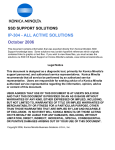
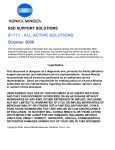
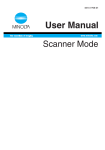

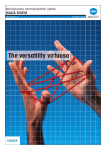
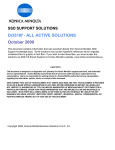

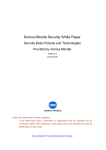

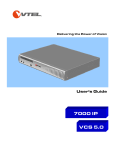
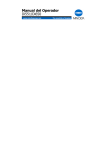
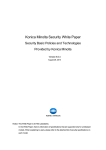

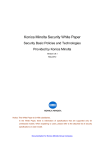
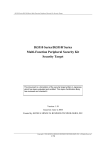
![User's Guide [Advanced Scan Operations]](http://vs1.manualzilla.com/store/data/006865872_1-8b3a85e3ed58d035968500e47824ff56-150x150.png)
